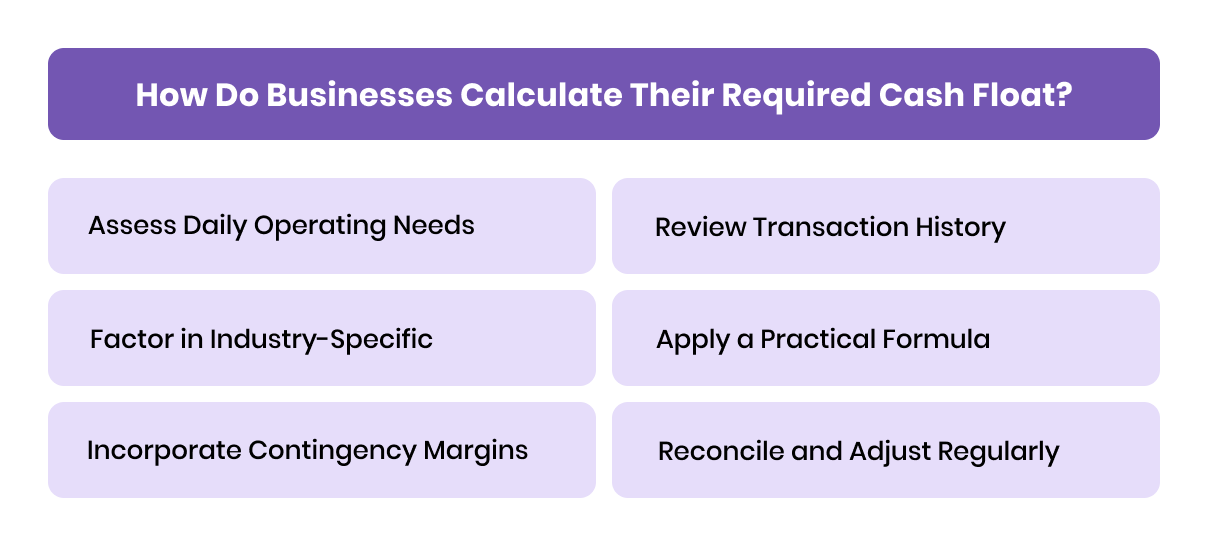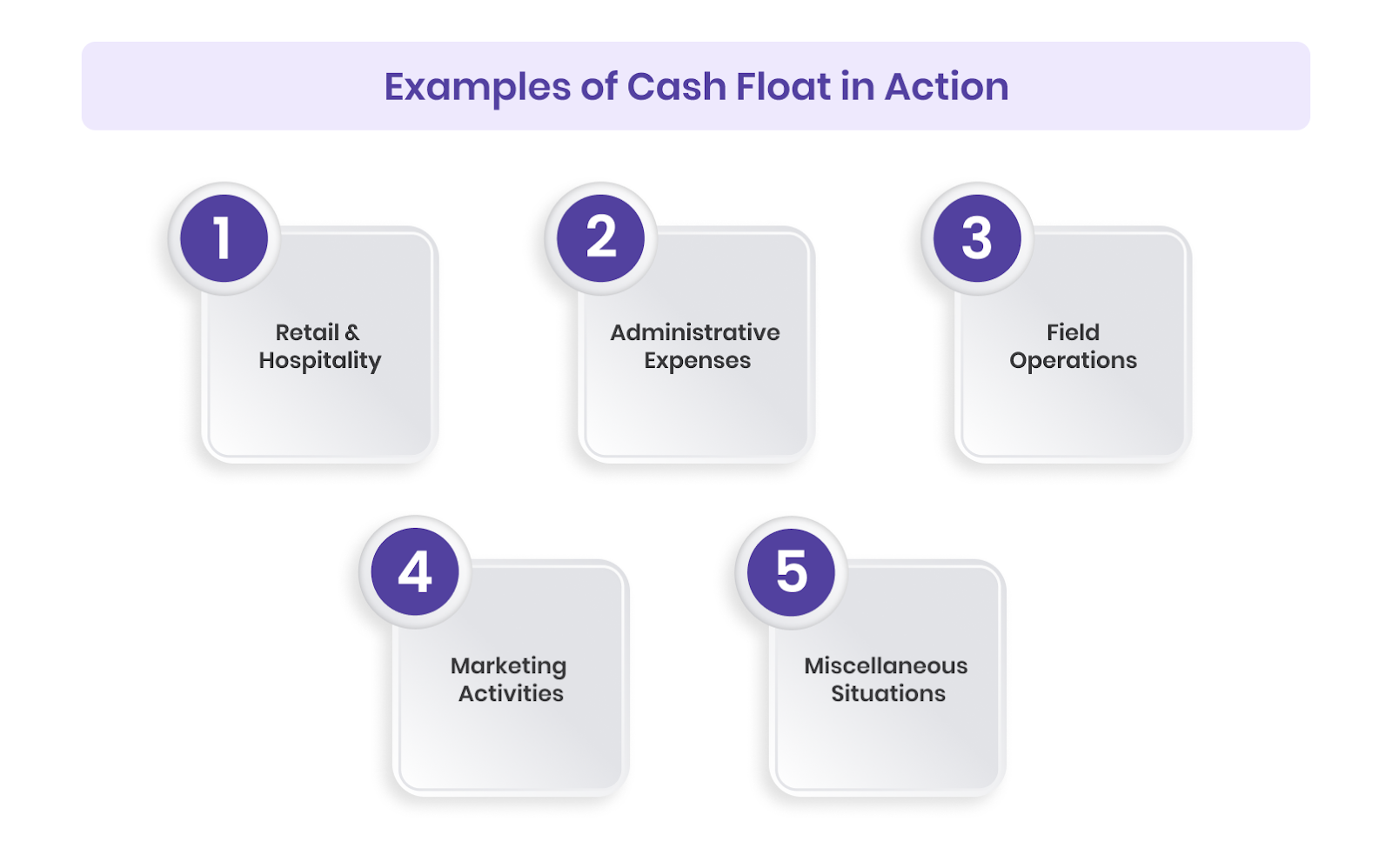Even experienced finance teams can face daily disruptions when cash floats aren’t managed effectively. In the UAE, where SMEs account for over 94% of all companies and contribute around 52% of non-oil GDP, these businesses handle thousands of small transactions every day.
Managing cash floats is a strategic tool that helps maintain smooth operations, stay compliant, and improve liquidity. This article explains how businesses can calculate, monitor, and optimise cash floats to remain agile and financially resilient.
Key Takeaways:
- Calculate Float Size - Use average daily expenses × coverage days + 10–20% contingency to meet routine and unexpected costs.
- Policy & Guidelines - Establish clear rules for float usage, approvals, and documentation to maintain consistency and prevent misuse.
- Industry & Operational Needs - Adjust float based on sector requirements, seasonal variations, and new expense categories.
- Monitor & Reconcile - Track usage in real time, reconcile regularly, and appoint a custodian to ensure transparency and control.
- Optimize with Technology - Automate float tracking, approvals, and reconciliation using digital tools or AI-powered platforms.
How Do Businesses Calculate Their Required Cash Float?

Determining the right cash float is all about balance. Businesses need enough funds on hand to manage daily operations smoothly, but not so much that valuable capital sits idle. Calculating it involves examining everyday expenses closely, the frequency of transactions, and the specific operational needs of the business.
Here's how businesses calculate their required cash float:
1. Assess Daily Operating Needs
The first step is to identify the essential expenses that require cash or near-cash payments on a daily basis. These often include:
- Petty cash payments: Office supplies, courier charges, or refreshments for client meetings that can’t be postponed.
- Operational running costs: Local transport, site visits, or urgent retail counter purchases.
- Departmental allowances: In sectors like construction, real estate, or healthcare, teams may need daily funds for project- or site-based needs.
Finance leaders usually calculate the average daily requirement for each category by reviewing expense logs. This ensures the float is sufficient to meet recurring needs without drawing unnecessarily from reserves.
2. Factor in Industry-Specific Variations
Different industries require different float strategies. Here’s an overview of them:
- Retail and hospitality: These sectors often need higher floats to manage frequent small payments such as supplier advances, vendor bills, or refunds. For example, a hotel might keep extra float for last-minute guest requests or urgent maintenance.
- Construction and real estate: Projects often demand site-level floats to cover casual labour wages, emergency repairs, or quick material purchases. These floats must be carefully tracked to prevent misuse.
- Healthcare and logistics: Hospitals may need immediate funds for urgent procurement like medicines or supplies, while logistics firms rely on floats for driver allowances or unexpected route expenses.
By mapping these industry patterns, businesses avoid a one-size-fits-all approach and design floats that fit their operational realities.
3. Incorporate Contingency Margins
Even with precise planning, unexpected expenses are bound to arise. To prevent disruptions, CFOs in the UAE and KSA typically add a 10–20% contingency buffer.
For example, a logistics company budgeting AED 10,000 daily for allowances might add a buffer of AED 2,000 for route diversions or urgent supplier payments. This buffer ensures teams can handle surprises quickly without breaking policy or dipping into reserves.
4. Review Transaction History for Patterns
Accurate float calculations rely on historical data. Reviewing three to six months of records provides insights into:
- Average daily spend: How much is typically withdrawn and used?
- Spending peaks and troughs: For example, retail businesses may spend more during festive seasons.
- VAT compliance gaps: Whether receipts were VAT-compliant, since non-compliant expenses cannot be claimed during VAT filings.
This analysis helps forecast future float requirements and ensures compliance with the UAE Federal Tax Authority (FTA) rules.
5. Apply a Practical Formula
Many finance teams use a structured formula to calculate float size:
(Average Daily Cash Requirement × Number of Days to Cover) + Contingency Margin
Follow these steps for the calculation:
- Determine average daily spend (AED 5,000)
- Decide coverage period (5 days)
- Add contingency buffer (15%).
Calculation: (AED 5,000 × 5) + 15% = AED 28,750
This method ensures float planning is transparent and can be defended in audits or board reviews.
6. Reconcile and Adjust Regularly
A cash float must evolve with operations. Finance leaders should:
- Reconcile weekly or monthly: Make sure balances match actual expenses, and investigate any discrepancies immediately.
- Scale with growth: A construction firm opening new project sites or a retailer expanding stores in KSA will likely need larger floats.
- Trim excess: If floats remain underused, surplus funds can be reduced and redirected toward investments or reserves.
This cycle of reviewing, adjusting, and optimising keeps the float lean, compliant, and aligned with business growth.
Calculating the required float becomes more practical when we look at real-world examples of how businesses use it.
Examples of Cash Float in Action

Cash float may be small in value, but it plays a big role in helping businesses cover their daily operational expenses smoothly. By providing quick access to funds, it ensures that minor but essential transactions are handled without delays, keeping operations efficient.
Below are some practical examples of how cash float is used across different industries and business functions:
Retail and Hospitality
In retail and hospitality, a cash float plays a crucial role in managing everyday expenses. It covers everything from giving customers their change to handling urgent, unexpected costs, ensuring that daily operations continue smoothly without interruptions.
For example, a hotel may keep a cash float at the front desk to cover small expenses like paying for a taxi, offering quick refunds for damaged items, or buying essentials such as towels or toiletries if a supplier runs late.
In retail stores, cash floats are used to give customers their change, especially when transactions involve both cash and cards. Staff can also rely on the float to purchase essential supplies or handle minor repairs without waiting for approvals from management.
Office and Administrative Expenses
In corporate offices, managing small but regular expenses becomes much easier with a cash float. It allows teams to take care of office supplies, minor maintenance, or incidentals like parking fees without going through long requisition processes or waiting for checks.
For instance, an office administrator may use the cash float to buy pens, printer ink, or notepads, or to pay for urgent small repairs to office equipment. It can also be used for quick reimbursements of employee out-of-pocket expenses during business trips or meetings.
Also Read: Small Business Expense Reimbursement Policy Best Practices
Field Operations and Logistics
For businesses that rely on teams in the field, such as logistics firms, delivery services, or construction companies, a cash float is especially useful for covering on-the-spot expenses. These costs are often unpredictable and need immediate payment.
For example, a logistics company may give its drivers a float to handle tolls, parking fees, minor fuel top-ups, or urgent repairs. Similarly, a construction crew might use a float to purchase emergency tools or materials if equipment breaks down on-site.
Events and Marketing Activities
Events and marketing campaigns often come with last-minute needs and unforeseen costs. Having a cash float on hand allows teams to react quickly and manage expenses that pop up during execution.
For instance, at an event, a marketing team may need to buy extra branded items, food, or printed materials to meet sudden demands. Organisers can also use a float to pay for transport, tip service staff, or arrange emergency decorations.
Emergency or Miscellaneous Situations
A cash float also serves as a safety net for unexpected situations. Emergencies can’t always be planned for, and having funds readily available makes it easier for businesses to respond quickly and effectively.
For example, a small business might need to urgently repair a broken air conditioning unit during peak summer, or a restaurant may need to fix a key piece of kitchen equipment to keep operations running smoothly.
Seeing it in action makes it easier to understand the importance of proper management and ongoing monitoring.
Managing and Monitoring Cash Float
Effectively managing and monitoring a cash float is key to keeping business operations running smoothly and expenses under control. When handled properly, a cash float prevents disruptions caused by insufficient funds, reduces the risk of misuse, and ensures financial transparency.
To get the best results, businesses can follow a few strategies and best practices that make cash float management more efficient and reliable:
Set Clear Float Policies
The first step in managing a cash float is to establish clear, well-documented policies that outline how the float should be used, replenished, and monitored. It involves:
- Approval Processes: Assign specific people who are authorised to access and use the cash float. Put in place an approval flow for spending and replenishment requests.
- Usage Guidelines: Define the types of expenses the float can be used for, such as office supplies, travel reimbursements, or emergency repairs, and set limits on how much can be spent per transaction.
- Documentation Requirements: Require that a receipt or voucher support every transaction. This keeps things transparent and makes reconciliation simpler.
Track Cash Float Usage in Real Time
Keeping track of the float in real time helps businesses stay on top of balances and usage. This allows for quick adjustments and avoids situations where the float runs dry unexpectedly. It involves:
- Float Tracking Tools: Use accounting software or digital platforms that track float activity in real time. This could be a simple spreadsheet or an integrated tool, which categorises expenses as they happen.
- Automated Notifications: Set up alerts when usage crosses limits or the balance falls below a minimum level. This helps maintain the float without constant manual oversight.
Replenish Float Regularly
A healthy float depends on regular replenishment. By setting up a structured schedule, businesses can make sure funds are available whenever needed. It involves:
- Set Replenishment Triggers: Decide when to top up the float, after a set number of transactions, or once the balance drops below a certain level.
- Automatic Replenishment Systems: Where possible, automate replenishments through your bank or accounting software, so funds are added without delay.
Conduct Regular Reconciliation
Reconciling float transactions on a regular basis helps confirm that recorded expenses match actual usage. This maintains accuracy and builds accountability. It involves:
- Monthly or Weekly Reconciliations: Compare the float balance with receipts and records at regular intervals, based on transaction volume.
- Cross-check Receipts and Vouchers: Verify that all documentation matches the amount and purpose of each expense.
Assign a Responsible Custodian
Appointing someone to oversee the float makes management easier and adds a clear line of accountability. It involves:
- Appointing a Custodian: Assign one person or a small team to track float usage, replenish funds, and ensure documentation is in place.
- Clear Reporting Structure: Have the custodian report regularly on float status and usage.
Use Technology for Automation
Digital solutions can simplify float management by automating repetitive tasks like recording transactions, replenishments, and reconciliations. Tools integrate smoothly with accounting systems to simplify the process. It involves:
- Integrating Float Management Systems: Use platforms that connect with your accounting software for faster, more accurate tracking.
- Automating Expense Verification: Rely on AI-powered tools to match receipts with expenses and log them correctly.
Also Read: Step-by-Step Automated Invoice Processing and Its Benefits
Periodically Review Float Requirements
As businesses evolve, their cash float needs may change. Regularly reviewing float levels ensures they remain in step with current operations. It involves:
- Adjust Float Based on Business Needs: Reassess the float during periods of growth, new product launches, or market expansion.
- Account for Seasonal Fluctuations: Adapt float levels to peak periods or reduce them in slower seasons.
Once managed effectively, businesses can focus on adjusting their cash float to improve efficiency even further.
When to Adjust Your Cash Float

Adjusting your cash float at the right time is key to maintaining operational efficiency and financial control. While having a cash float is important, businesses must periodically reassess their size and usage based on changes in operations, market conditions, or internal requirements.
Here are key moments when businesses should consider adjusting their cash float:
1. Changes in Business Size or Scope
As businesses grow or scale down, the need for a cash float may change. A growing company may require a larger float to support increased transactions, while a business that is scaling back may need to reduce its float to prevent overfunding. It involves:
- For Growing Businesses: If the number of employees or departments increases, or if new locations are opened, the float may need to be adjusted to accommodate more frequent expenses.
- For Shrinking Businesses: If the business is downsizing or reducing its scope, reducing the float can free up capital for other uses without affecting daily operations.
2. Changes in Operational Expenses
If a business experiences significant fluctuations in daily expenses due to seasonal changes, new projects, or other operational shifts, the cash float should be adjusted accordingly to reflect those changes. It involves:
- Seasonal Variations: Many businesses face spikes in expenses during peak seasons (e.g., retail businesses during holidays). Increasing the float during these periods ensures sufficient cash availability to manage higher transaction volumes.
- New Operational Needs: If the business expands its service offerings or enters new markets, the float may need to increase to support additional operational costs, such as transport, materials, or employee reimbursements.
3. Introduction of New Expense Categories
When businesses start incurring new types of expenses, such as increased travel costs, new subscriptions, or other vendor-based services, the float should be adjusted to account for these new outflows. It involves:
- Adding New Expense Categories: If a company introduces a new travel policy requiring employees to make frequent business trips, the cash float should increase to cover the expenses of transportation, meals, and incidentals.
- Increased Project Costs: If a company starts a new, high-value project that requires frequent small purchases, the float should be adjusted to accommodate these added expenses.
4. Changes in Payment Methods or Supplier Relationships
Changes in how a business handles payments or works with suppliers may require adjustments to the cash float. For example, if suppliers now require upfront payments or if payment terms change, businesses may need a larger float to cover these immediate costs. It involves:
- Supplier Terms: If a business shifts to paying suppliers earlier or needs to cover additional vendor-related costs upfront, the cash float should be adjusted to reflect this change.
- Payment Method Changes: If a business starts using new payment methods that require more frequent cash outflows, such as subscription services or regular purchases on demand, this can trigger the need for a float increase.
5. Business Cycle or Economic Factors
In times of economic uncertainty or during downturns, businesses may need to reassess their cash float to maintain financial stability. Similarly, during periods of strong growth or profitability, businesses may opt to adjust their float for more flexibility. It involves:
- Economic Slowdowns: During slower business cycles or economic downturns, a business may need to lower its float as operating expenses decrease, and capital becomes scarcer.
- Strong Business Growth: During periods of rapid growth or economic boom, increasing the cash float ensures that the business has enough liquidity to support its expansion without disruption.
6. Cash Flow Challenges or Delays
When businesses face cash flow challenges or delays in receivables, they may need to increase their cash float temporarily to cover the gap until payments are received. It involves:
- Delayed Payments from Clients: If customers delay payments or the business has significant outstanding invoices, adjusting the float can cover these temporary shortfalls.
- Unexpected Cash Flow Gaps: For businesses dealing with irregular cash flow, having a larger float helps smooth over the financial bumps caused by delayed income.
7. End-of-Year or Tax Planning
At the end of a fiscal year or before filing taxes, businesses may adjust their cash float to ensure they have sufficient funds for tax payments or other year-end expenses. It involves:
- Year-End Expenses: Preparing for tax season or annual audits may require additional cash for tax-related expenses or last-minute adjustments.
- Tax Payment: If businesses expect a large tax bill, adjusting the float ensures that these payments can be made promptly without relying on external credit or loans.
Even with careful planning, businesses can face challenges, so it’s important to know how to handle them.
Challenges of Managing Cash Float & How To Solve Them
Managing a cash float is vital for keeping business operations smooth, but like any financial process, it does come with challenges. If not addressed, these issues can lead to inefficiencies, delays, or even mismanagement. The good news is that most of these challenges have practical solutions.
Below are some of the most common problems businesses face when handling a cash float, along with ways to overcome them.
How Alaan Helps Businesses Manage Their Cash Float Effectively?
Maintaining the right cash float is key for businesses that want to keep daily operations running smoothly while staying financially flexible. At Alaan, we offer a complete spend management platform that simplifies cash flow management, ensuring funds are available when needed, without locking away unnecessary capital.
Here’s how Alaan supports effective cash float management:
- Smart Corporate Cards with Custom Controls: Provide employees with physical and virtual corporate cards, each set with tailored spending limits and merchant restrictions. This ensures float usage is controlled, avoiding overspending while keeping operations flexible.
- Real-Time Cash Flow Visibility: Gain instant insights into your cash float with detailed reports on spending patterns, departmental usage, and any discrepancies. This visibility helps businesses make smarter decisions and optimise float allocation.
- Smooth Integration with Accounting Systems: Alaan connects effortlessly with accounting tools like QuickBooks and Xero, automatically reconciling float-related transactions. This integration reduces manual work and strengthens financial accuracy.
- Custom Spend Controls and Reporting: Set department-specific limits and policies to ensure float is allocated wisely. Alaan also provides detailed analytics and reporting, giving businesses better control over float usage and budgeting.
- AI-Powered Expense Automation: Alaan’s AI speeds up key tasks like receipt matching, expense categorisation, and error detection. This makes float management more efficient, saves time for finance teams, and ensures compliance.
Wrapping Up
Managing your cash float is an important part of keeping business operations smooth and avoiding unnecessary disruptions. By setting the right float size, tracking how it’s used, and reviewing it regularly, you can give your business the flexibility to handle everyday expenses without locking away valuable capital.
At Alaan, we know how crucial efficient cash flow management is. Our AI-powered platform helps businesses optimise funds with real-time visibility, automated expense tracking, and smooth integration, making float and expense management much simpler.
Book a quick demo today to see how Alaan can make cash flow management easier and improve your business’s financial efficiency.
FAQs
1. What is Cash Float?
A cash float is a small amount of cash that businesses keep on hand to handle everyday expenses. It helps keep daily operations running smoothly without waiting for bank transfers or depending on electronic payments.
2. What is the difference between cash float and cash reserve?
A cash float covers daily operational needs, such as petty cash or small supplier payments, while cash reserves serve as a larger financial safety net for emergencies or strategic investments.
3. How do businesses determine the size of their cash float?
Most businesses calculate their average daily expenses for small purchases and set the float to cover a few days’ worth of these transactions. To stay prepared for the unexpected, a contingency margin of 10–20% is usually added.
4. How does a cash float help with VAT compliance?
When managed properly, a cash float makes it easier to record even minor transactions in line with VAT requirements. This ensures businesses can track VAT on small purchases and claim recovery while staying fully compliant.
5. How can businesses manage a float across multiple departments?
Companies often assign specific float amounts to each department based on their needs and then track usage centrally through digital tools. Regular reconciliations and clear usage policies ensure the float is managed smoothly across teams.
6. What happens if a business ties up too much cash in a float?
Keeping excess funds in a float can reduce working capital that could otherwise support growth or strategic investments. Reviewing and adjusting the float regularly helps maintain the right balance for operational efficiency.
7. Can a cash float be used for larger expenses?
A float is mainly meant for small, routine expenses. Bigger costs should generally be paid through business reserves or bank accounts. That said, the float can be temporarily increased for urgent but manageable expenses, such as minor equipment repairs.


.avif)






